苏教版初中英语七年级下册Unit1《DreamhomesReading1》课件
- 格式:ppt
- 大小:1.77 MB
- 文档页数:17
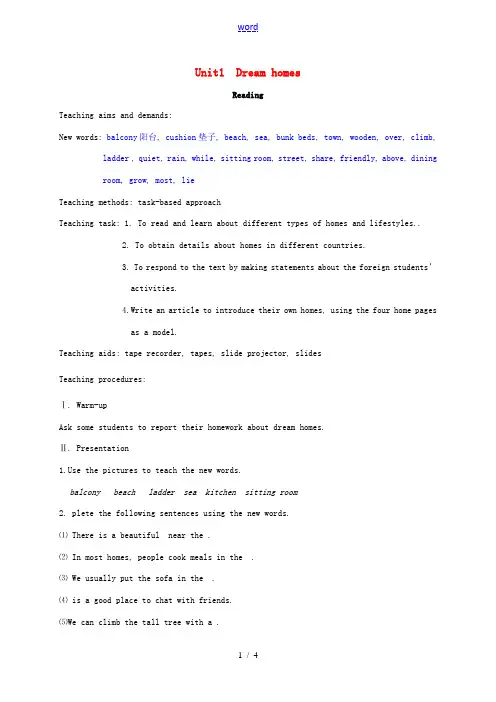
Unit1 Dream homesReadingTeaching aims and demands:New words: balcony阳台, cushion垫子, beach, sea, bunk beds, town, wooden, over, climb, ladder , quiet, rain, while, sitting room, street, share, friendly, above, diningroom, grow, most, lieTeaching methods: task-based approachTeaching task: 1. To read and learn about different types of homes and lifestyles..2. To obtain details about homes in different countries.3. To respond to the text by making statements about the foreign students’activities.4.Write an article to introduce their own homes, using the four home pagesas a model.Teaching aids: tape recorder, tapes, slide projector, slidesTeaching procedures:Ⅰ. Warm-upAsk some students to report their homework about dream homes.Ⅱ. Presentatione the pictures to teach the new words.balcony beach ladder sea kitchen sitting room2. plete the following sentences using the new words.⑴ There is a beautiful near the .⑵ In most homes, people cook meals in the .⑶ We usually put the sofa in the .⑷ is a good place to chat with friends.⑸We can climb the tall tree with a .Ⅲ.ListeningNow, let’s listen to the home pages of four foreign students, after you listen to them, please do some “T” or “F” exercises. Check the answers with the whole c lass.1.Stephen lives near the sea.2.There are more than ten rooms in Stephen’s house.3.Madee lives in a wooden house in the hills.4.Madee has a small family.5.Neil has a TV in the kitchen.6.Neil’s dog sleeps in the sitting room.7.Anna’s flat is on a busy street.8.Anna shares a bedroom with her brother.9.Stephen’s favourite place is the balcony.10.Anna lives in a large flat.Ⅳ. ReadingSs read the articles by yourselves. Then check their reading.Language points:1.We sit on the big floor cushions and look out at the beach and the sea.look out (of) …e.g. Do n’t look out of the window in class.look at / look around / look for / look like / look forward to / look after / look up 2. I live with my family in a wooden house.= I live with my family in a house made of wood.wooden(adj.) → wood (n.)e.g. We need some wooden chairs.This house is made of wood.3. I climb a ladder to get into my house. =I get into my house with a ladder.①e.g. I often go to her house to see Uncle Li.Daniel often goes to the shopping mall to play puter games.② get into → get out ofget into the car get out of the car4. I do not have my own bedroom.own(adj./v.) → owner (n.)e.g. I see with my own eyes.Who’s the owner of this pen?= Who owns this pen?5. My family and I often sit in the kitchen while my mother makes dinner.e.g. I am reading books while my brother is watching TV.She called while you were out.6. I share a bedroom with my sister.share sth with sbe.g. The boy shared his toy with other childrenshare in sthe.g. We should share in our sorrows as well as joys.7. Our neighbours are friendly and we are happy here.e.g. I’m friendly with her.be friendly to sbe.g. People are usually friendly to foreign friends.8.Simon wrote down the meaning of some of the words.①write + n. +down=write down +n. write it /them downe.g. Can you write down the words on your book ?= Can you write the words on your book?OK, I’ll write them down.②meaning (n.) → mean(v.)e.g. What’s the meaning of “quick?= What does “quick” mean?9.A garden is the best place to grow flowers.e.g. It’s really a good place to go.I’m hungry. Do you have anything to eat?10.Stephen is lying on his bunk beds.lie → lying tie → tying die → dyingtell a liee.g. Don’t tell a lie any more . It’s not good for you.Ⅴ.Discussion (task)Divide the class into groups of six. Ask students to draw picture of their homes. Students look at their pictures and talk about their homes.Ⅵ.Sum-upGo through the new words and the language points learnt during this lesson.Ⅶ. Homework1. Review the contents of this lesson.2. Write an article to introduce their own homes, using the four home pages as a model. 教后记:。
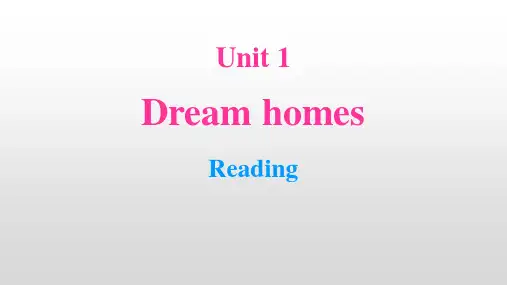
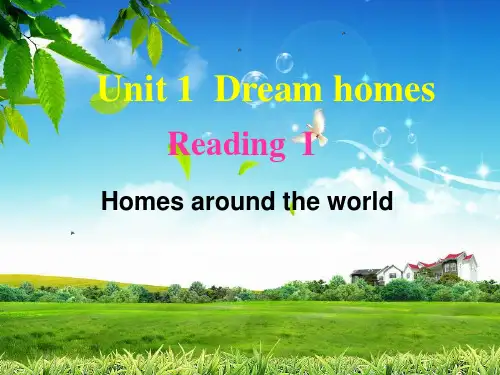
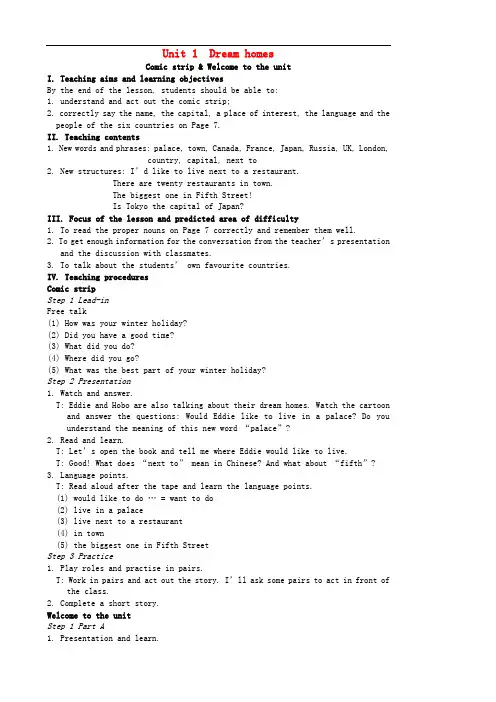
Unit 1 Dream homesComic strip & Welcome to the unitI. Teaching aims and learning objectivesBy the end of the lesson, students should be able to:1. understand and act out the comic strip;2. correctly say the name, the capital, a place of interest, the language and thepeople of the six countries on Page 7.II. Teaching contents1. New words and phrases: palace, town, Canada, France, Japan, Russia, UK, London,country, capital, next to2. New structures: I’d like to live next to a restaurant.There are twenty restaurants in town.The biggest one in Fifth Street!Is Tokyo the capital of Japan?III. Focus of the lesson and predicted area of difficulty1. To read the proper nouns on Page 7 correctly and remember them well.2. To get enough information for the conversation from the teacher’s presentationand the discussion with classmates.3. To talk about the student s’ own favourite countries.IV. Teaching proceduresComic stripStep 1 Lead-inFree talk(1) How was your winter holiday?(2) Did you have a good time?(3) What did you do?(4) Where did you go?(5) What was the best part of your winter holiday?Step 2 Presentation1. Watch and answer.T: Eddie and Hobo are also talking about their dream homes. Watch the cartoon and answer the questions: Would Eddie like to live in a palace? Do you understand the meaning of this new word “palace”?2. Read and learn.T: Let’s open the book and tell me where Eddie would like to live.T: Good! What does “next to” mean in Chinese? And what about “fifth”? 3. Language points.T: Read aloud after the tape and learn the language points.(1) would like to do … = want to do(2) live in a palace(3) live next to a restaurant(4) in town(5) the biggest one in Fifth StreetStep 3 Practice1. Play roles and practise in pairs.T: Work in pairs and act out the story. I’ll ask some pairs to act in front of the class.2. Complete a short story.Welcome to the unitStep 1 Part A1. Presentation and learn.Show pictures to learn about different countries: Japan, the USA, France, Canada, the UK and Russia.JapanT: Boys and girls, please look at the picture. Who knows the name of this place?T: Yes, it’s Mount Fuji. There is thick white snow at the top of the mountain all year round. The view in and around this mountain is really wonderful. Do you know which country it is in?T: That’s right. It’s in Japan. Mount Fuji is near Tokyo, the capital of Japan.Do you understand the meaning of “capital”?T: What do we call the people who live in Japan? Yes, we call them Japanese or Japanese people. And “Japanese”also means the language that Japanese people speak.T: We’ve learnt something about Japan. Would you please say something about this picture or this country? For example, the capital of Japan is Tokyo. Who’d like to go on?T: Good job! So much for this picture. Now, look at the next picture.2. Look and match.Finish Part A on Page 7.3. Complete and say.T: We’ve learnt a lot about different countries. Let me help you remember them well. Look at this table. First, would you please complete it?T: Would you please say several sentences about each country? You can first practise with your partner. Then I’ll ask some of you to report one of them to the class.Step 2 Part B1. Listen and answer.(1) Which picture are Annie and Simon talking about?(2) What do you know from their conversation?2. Read aloud.3. Make up similar conversations.Step 3 PracticeShow pictures of famous people from the six countries and ask the students to do the question chains. Vote for the best question and the best answer.T: I’ll show you some famous people from the six countries. Let’s do a “question chain”. Six questions for each of them. Let’s see who will raise the best question and who will give the best answer. Are you ready? OK. Let’s start from …T: Great! Most of you did a very good job. Which question and which answer do you think are the best?V. Homework1. Tell your parents about your favourite country among the six in English.2. Remember the new language points.。
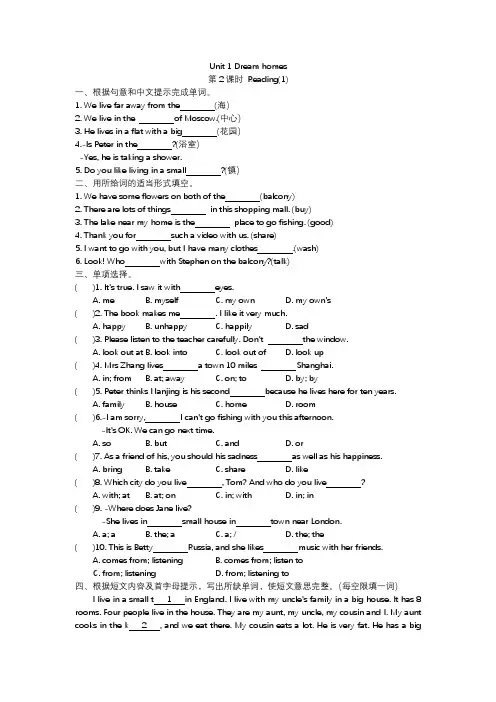
Unit 1 Dream homes第2课时Reading(1)一、根据句意和中文提示完成单词。
1. We live far away from the (海)2. We live in the of Moscow.(中心)3. He lives in a flat with a big (花园)4.-Is Peter in the ?(浴室)-Yes, he is taking a shower.5. Do you like living in a small ?(镇)二、用所给词的适当形式填空。
1. We have some flowers on both of the (balcony)2. There are lots of things in this shopping mall. (buy)3. The lake near my home is the place to go fishing. (good)4. Thank you for such a video with us. (share)5. I want to go with you, but I have many clothes .(wash)6. Look! Who with Stephen on the balcony?(talk)三、单项选择。
( )1. It’s true. I saw it with eyes.A. meB. myselfC. my ownD. my own's( )2. The book makes me . I like it very much.A. happyB. unhappyC. happilyD. sad( )3. Please listen to the teacher carefully. Don't the window.A. look out atB. look intoC. look out ofD. look up( )4. Mrs Zhang lives a town 10 miles Shanghai.A. in; fromB. at; awayC. on; toD. by; by( )5. Peter thinks Nanjing is his second because he lives here for ten years.A. familyB. houseC. homeD. room( )6.-I am sorry, I can't go fishing with you this afternoon.-It's OK. We can go next time.A. soB. butC. andD. or( )7. As a friend of his, you should his sadness as well as his happiness.A. bringB. takeC. shareD. like( )8. Which city do you live , Tom? And who do you live ?A. with; atB. at; onC. in; withD. in; in( )9. -Where does Jane live?-She lives in small house in town near London.A. a; aB. the; aC. a; /D. the; the( )10. This is Betty Russia, and she likes music with her friends.A. comes from; listeningB. comes from; listen toC. from; listeningD. from; listening to四、根据短文内容及首字母提示,写出所缺单词,使短文意思完整。
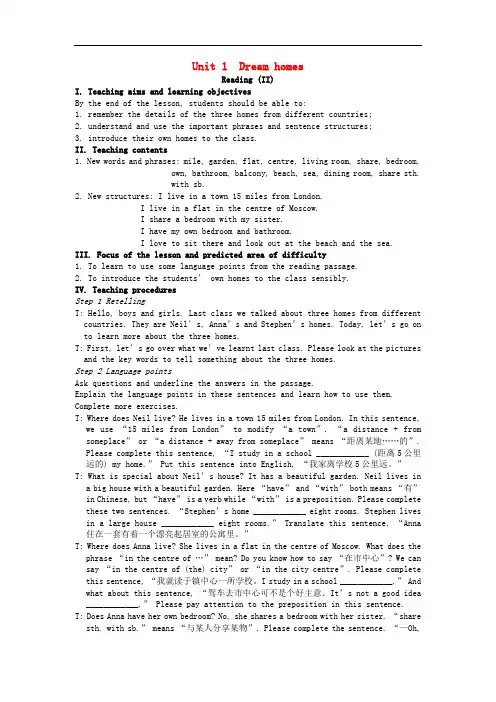
Unit 1 Dream homesReading (II)I. Teaching aims and learning objectivesBy the end of the lesson, students should be able to:1. remember the details of the three homes from different countries;2. understand and use the important phrases and sentence structures;3. introduce their own homes to the class.II. Teaching contents1. New words and phrases: mile, garden, flat, centre, living room, share, bedroom,own, bathroom, balcony, beach, sea, dining room, share sth.with sb.2. New structures: I live in a town 15 miles from London.I live in a flat in the centre of Moscow.I share a bedroom with my sister.I have my own bedroom and bathroom.I love to sit there and look out at the beach and the sea.III. Focus of the lesson and predicted area of difficulty1. To learn to use some language points from the reading passage.2. To introduce the students’ own homes to the class sensibly.IV. Teaching proceduresStep 1 RetellingT: Hello, boys and girls. Last class we talked about three homes from different countries. They are Neil’s, Anna’s and Stephen’s homes. Today, let’s go on to learn more about the three homes.T: First, let’s go over what we’ve learnt last class. Please look at the pictures and the key words to tell something about the three homes.Step 2 Language pointsAsk questions and underline the answers in the passage.Explain the language points in these sentences and learn how to use them. Complete more exercises.T: Where does Neil live? He lives in a town 15 miles from London. In this sentence, we use “15 miles from London”to modify “a town”. “a distance + from someplace” or “a distance + away from someplace” means “距离某地……的”.Please complete this sentence, “I study in a school ____________ (距离5公里远的) my home.” Put this sentence into English, “我家离学校5公里远。
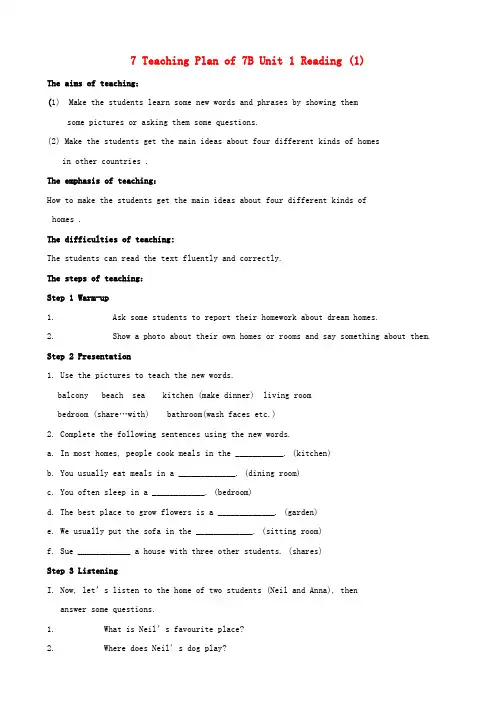
7 Teaching Plan of 7B Unit 1 Reading (1)The aims of teaching:(1) Make the students learn some new words and phrases by showing themsome pictures or asking them some questions.(2) Make the students get the main ideas about four different kinds of homesin other countries .The emphasis of teaching:How to make the students get the main ideas about four different kinds ofhomes .The difficulties of teaching:The students can read the text fluently and correctly.The steps of teaching:Step 1 Warm-up1. Ask some students to report their homework about dream homes.2. Show a photo about their own homes or rooms and say something about them. Step 2 Presentation1. Use the pictures to teach the new words.balcony beach sea kitchen (make dinner) living roombedroom (share…with)bathroom(wash faces etc.)2. Complete the following sentences using the new words.a. In most homes, people cook meals in the ___________. (kitchen)b. You usually eat meals in a _____________. (dining room)c. You often sleep in a ____________. (bedroom)d. The best place to grow flowers is a _____________. (garden)e. We usually put the sofa in the _____________. (sitting room)f. Sue ____________ a house with three other students. (shares)Step 3 ListeningI. Now, let’s listen to the home of two students (Neil and Anna), thenanswer some questions.1. What is Neil’s favourite place?2. Where does Neil’s dog play?3. What do Anna’s family often do in thei r living room?4. Who does Anna share a bedroom with?II Then, let’s listen to the home page of another foreign student (Stephen),after you listen to it, please do some “T” or “F” exercises. Check the answers with the whole class.1. Stephen lives near the sea.2. There are more than ten rooms in Stephen’s house.3. Stephen can’t see the beach from the bedroom windows. ______Step 4 ReadingSs read the articles by themselves. Then check their reading.Fill in the blanks:1 Neil lives in a ______ 15 _______ from London. His _____ place is the________. He and his family often _______ there and _______ a cup of tea.They have a ______ ______. Neil always _______ fun with his dog _____.2 Anna lives with her family in a ______ on the _______ floor in the ____Of Moscow. Her home is not _____so she has to _____ a bedroom ____ her sister. They often _____ to music ____ bed. ______ dinner, Anna and herfamily like to _____ TV and chat in their ______ ______ room.3. Stephen l______ in a large house in Los Angeles, California. It has ____rooms. His f________ place is the b______. He can play games, r _____comics and c_____ with friends there. They sit on the big floor and l______ o_____ at the beach and the sea from the bedroom windows.Step 5 Talk about your own homes.Step 6 Homework1. Listen and read after class.2. Write about your own homes.。
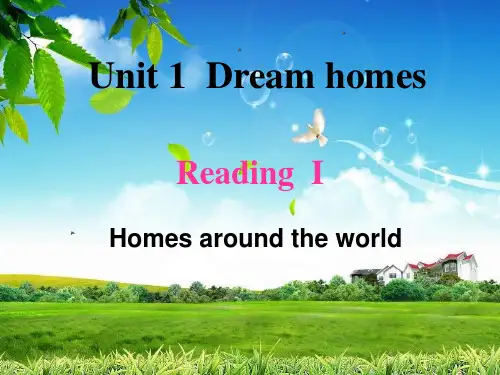
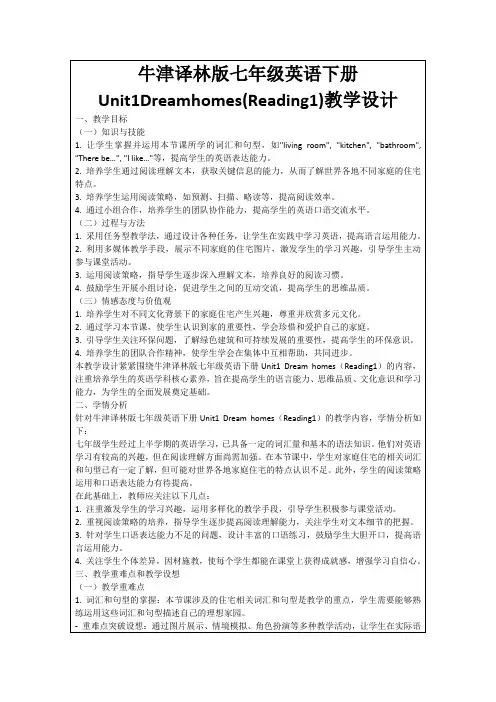
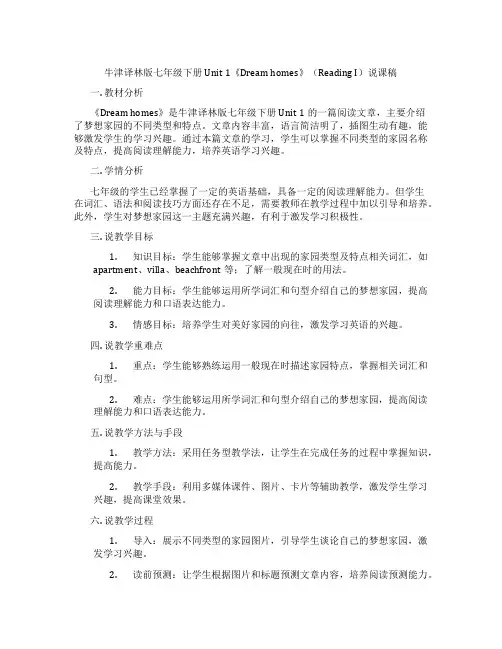
牛津译林版七年级下册Unit 1《Dream homes》(Reading I)说课稿一. 教材分析《Dream homes》是牛津译林版七年级下册Unit 1的一篇阅读文章,主要介绍了梦想家园的不同类型和特点。
文章内容丰富,语言简洁明了,插图生动有趣,能够激发学生的学习兴趣。
通过本篇文章的学习,学生可以掌握不同类型的家园名称及特点,提高阅读理解能力,培养英语学习兴趣。
二. 学情分析七年级的学生已经掌握了一定的英语基础,具备一定的阅读理解能力。
但学生在词汇、语法和阅读技巧方面还存在不足,需要教师在教学过程中加以引导和培养。
此外,学生对梦想家园这一主题充满兴趣,有利于激发学习积极性。
三. 说教学目标1.知识目标:学生能够掌握文章中出现的家园类型及特点相关词汇,如apartment、villa、beachfront等;了解一般现在时的用法。
2.能力目标:学生能够运用所学词汇和句型介绍自己的梦想家园,提高阅读理解能力和口语表达能力。
3.情感目标:培养学生对美好家园的向往,激发学习英语的兴趣。
四. 说教学重难点1.重点:学生能够熟练运用一般现在时描述家园特点,掌握相关词汇和句型。
2.难点:学生能够运用所学词汇和句型介绍自己的梦想家园,提高阅读理解能力和口语表达能力。
五. 说教学方法与手段1.教学方法:采用任务型教学法,让学生在完成任务的过程中掌握知识,提高能力。
2.教学手段:利用多媒体课件、图片、卡片等辅助教学,激发学生学习兴趣,提高课堂效果。
六. 说教学过程1.导入:展示不同类型的家园图片,引导学生谈论自己的梦想家园,激发学习兴趣。
2.读前预测:让学生根据图片和标题预测文章内容,培养阅读预测能力。
3.快速阅读:让学生快速阅读文章,回答简单问题,检测阅读理解能力。
4.细节理解:引导学生深入阅读文章,找出描述家园特点的句子,讨论并回答问题。
5.语法讲解:讲解一般现在时的用法,让学生学会用一般现在时描述家园特点。
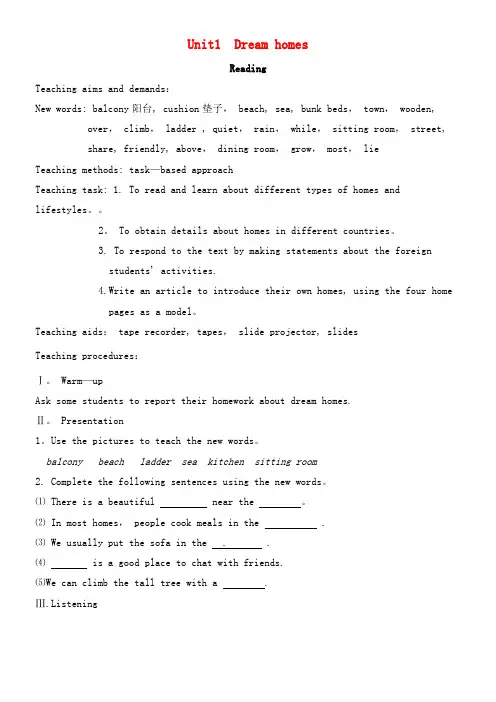
Unit1 Dream homesReadingTeaching aims and demands:New words: balcony阳台, cushion垫子, beach, sea, bunk beds, town, wooden, over, climb, ladder , quiet, rain, while, sitting room, street,share, friendly, above, dining room, grow, most, lieTeaching methods: task—based approachTeaching task: 1. To read and learn about different types of homes and lifestyles。
2。
To obtain details about homes in different countries。
3. To respond to the text by making statements about the foreignstudents' activities.4.Write an article to introduce their own homes, using the four homepages as a model。
Teaching aids: tape recorder, tapes, slide projector, slidesTeaching procedures:Ⅰ。
Warm—upAsk some students to report their homework about dream homes.Ⅱ。
Presentation1。
Use the pictures to teach the new words。
balcony beach ladder sea kitchen sitting room2. Complete the following sentences using the new words。
《Unit 1 Dream homes》Reading 1教案To learn the new words and expressionsTo read and learn about different types of homes and lifestylesTo obtain details about homes in different countriesA.教学过程Step 1 Check the preview homework together and solve the students’problem.Step2. PresentationsShow the students four pictures of different types of homes around the world. Ask them: Where would you like to live?Talk about homes in China, and get the students to say something about their own homes.Use pictures to talk about different rooms in a house. Teach new words: flat, wooden, over a river, sitting room, kitchen, balcony, and bathroom.Step 3 . Fast readingStephen RussiaMadee The UKNeil ThailandAnna The USA2. Play the tape for the students to listen to and read after it silently. Try to understand it.3. Ask the students to read the passage carefully. Answer some questions or fill in forms.Stephen Madee Neil AnnaWhere is he /she from?Where is his /her home?What is his/her favourite room?What can he / she do at home?What else do you know about him/her?Step 4. Reading aloudPlay the tape for the students to listen to and read after it loudly.Pair work. Get the students to read the four pages loudly. They can read to each other.Ask the class to read with the tape together.Step 5. A reading petition1. Choose a page for the students to prepare for three minutes.Ask them to read it carefully. Teacher gives help to less able students.2. Have the reading petition: each group reads the page together to see which group reads best. Step 6. ExercisesC. 学习过程:(一)、预习*导学:(能课前预习P8-9!你真是学习的小主人!)1.词汇预习在课文中找出下列内容词汇:beach, sea, town, river, over, neighbour, ladder, quiet, kitchen, child, second, share, friendly, grow, most, its, fifth, garden, flat, seventh, climb, rain, cook, into, balcony, wooden, while 词组:sitting room, dining room, chat with, over a river , make dinner, in the evenings, on a busy street, share--- with---, more than, look out at----, in the centre of , grow flowers句型:I live in ----I live / stay with----I am the second child of my family.It rains a lot.My family and I often sit in the kitchen while my mother makes dinner.根据上下文及插图猜测出生词的含义,你不会的有:______________________________________________________________________________试着朗读,对不会读的做标记,查字典注上音标,再试着读几遍,仍然不会的有:_______________________________________________________________________________2. 通过预习,你还有哪些方面存在疑问?(预习让你了解了许多知识?来检测一下吧?)A.根据课文填入适当的介词:1) Tom likes chatting ______ friends ______ the balcony.2) They often sit ______ the floor and look out ______ the beach.3) Madee lives ______ a small town _____ Thailand.4) Her house is _____ a river.5) She often climbs a ladder to get _____ her house.6) _____ the evenings, Neil watches TV ____ the sitting room.7) Amy lives _____the center ______ Moscow ______ her family _____ a flat _____ a busy street. B.连词成句:1) dog, I, sleeps, and, have, the, in, a, garden, he______________________________________2) my, with, I, live, family, house, a, in, wooden______________________________________3) think, friends, it, beautiful, my, is quiet, very, here, and____________________________________________4) a, with, I, my, bedroom, share, sister____________________________________________(二)、学习*研讨:我们来总结一下本课的知识点吧,如果在预习中不清楚的,现在可要注意哦!1. look out at the beach 向外看海滩。